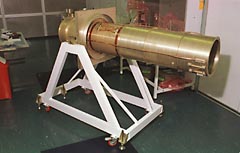
Side view of the OM telescope.
The OM was designed and constructed at the Mullard Space Science Laboratory (MSSL). The University of California at Santa Barbara (UCSB) is in charge of the digital electronics module (DEM) of the instrument.
The Optical/Ultraviolet Monitor (OM) is what most people would call a "normal" telescope. It has a 30-centimeter-wide mirror designed to focus optical and ultraviolet light coming from the same direction as the X-rays observed by the other instruments on XMM-Newton. This allows, for the first time, simultaneous observations of a target in the optical/UV and X-ray regions of the electromagnetic spectrum. This is important because studying different wavelengths gives us a picture of what different mechanisms are at work.
The OM has a field of view (17 x 17 arcmin, about 1/4 the area of the full Moon on the sky) matched to that of the XMM-Newton X-ray cameras. After being focused by two mirrors, the light is directed through a filter. The light then goes through an ultra-compact electronic image intensifier, which amplifies the light signal a million times before it falls on a silicon CCD chip capable of registering 100 frames/second. A 4x magnifier in the filter wheel also allows an option of "zooming in" on the central region of a field. The filter wheel also contains "grisms", devices that are part prism and part grating, allowing low-resolution spectroscopy.

Side view of the OM telescope. |
The OM was designed and constructed at the Mullard Space Science Laboratory (MSSL). The University of California at Santa Barbara (UCSB) is in charge of the digital electronics module (DEM) of the instrument. |